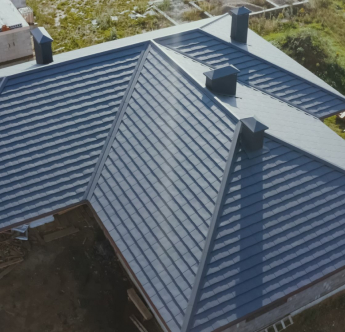Ventilate Your Home with a Soffit, Gable & Ridge Vent
It’s understandable that roof ventilation is often overlooked, as most people are simply worried about their roof keeping their home dry. However, a well-ventilated roof can make life easier and better for those living beneath it. Proper roof and attic ventilation can lower heating and cooling costs, improve interior comfort, and grant a longer life to roof shingles.
In the summertime, a properly ventilated roof allows hot air in the attic to escape, reducing the demand on your air conditioning system. In the winter, ventilation combines with good attic insulation to keep the roof surface cold, so that snow won’t melt on the roof surface and then freeze to form ice dams along the eaves.
JP Carroll Roofing installs and repairs ridge vents and other types of roof vents. We are Connecticut’s expert roofing contractors for roofing solutions that include roof repair, roof replacement and more.
Contact us at (860) 215-2644 for a free quote for ridge vent installation today.
Request your free estimate!
Frequently Asked Questions
Types of Roof Vents
There are several types of roof vents and different strategies for achieving effective roof ventilation.
Ridge vents:
Installed along the roof peak, ridge vents are probably the most important vents in any “passive” (non-electric) roof ventilation system. Hot air that accumulates inside the attic rises by convection and escapes outside through ridge vents.
As hot air escapes, fresh outside air is drawn into the attic through soffit vents. On an asphalt shingle roof, ridge vents are usually covered by a layer of shingles. The warmest air in the attic rises naturally to the roof peak and escapes outside through the ridge vents.
Soffit vents:
Soffit vents run parallel to the eaves along the soffit. These vents work with ridge and gable vents to promote good roof ventilation. Installed along the eaves of the roof, these vents are usually in the form of grilles that run the length of each soffit. By admitting outside air into the attic as warmer air leaves the attic through higher vents, soffit vents play a major role in effective roof ventilation.
Gable-end vents:
Installed near the peak of a gable end, this screened vent can allow hot air to leave the attic or fresh air to enter, depending on prevailing breezes and temperature conditions.
Powered attic ventilators (PAVs):
Sometimes referred to as attic fans, PAVs come in several forms. Some are designed to be mounted on the roof, while others mount in the attic floor or the gable end. All PAVs contain an electrically powered fan (usually controlled by a thermostat) that exhausts hot air from the attic on hot summer days.
A PAV should not be necessary if a roof has properly sized and installed ridge and soffit vents. While a PAV will exhaust hot air from the attic during hot weather, it consumes electricity and can suck cooled air from the living space through leaks in the attic floor.
For this reason, many home energy experts recommend passive roof ventilation instead of active ventilation with a PAV.
Keep Your Roof in Its Best Condition
If your roof is not well-ventilated, ask a roofing contractor about improving roof ventilation with ridge, soffit or gable-end vents. All these roof vents can be installed in an existing roof, or when your roofing is being replaced.
The specialists at JP Carroll Roofing can help you choose the right type of roof vents for your home. We can repair or install roof vents and improve your attic ventilation.
Our professional roofing services, including roof repair, are available throughout Connecticut and surrounding areas. Contact us at (860) 215-2644 for a free estimate.



